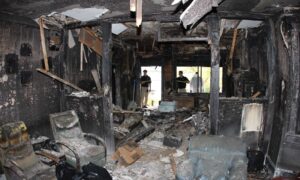Restoring a home after water damage can be a time-consuming process that requires careful planning and execution. The severity of the damage and various other factors can impact the timeline for restoration. It typically takes about 72 hours for the affected areas to completely dry, but repairing the damage caused can take several weeks or even months.
Key Takeaways:
- The restoration process for a water-damaged home can range from a few days to several weeks or months.
- The drying process involves removing standing water, using air movers and dehumidifiers, and addressing any mold growth.
- The size of the home, materials affected, and presence of asbestos or contamination can impact the restoration timeline.
- Assessing the extent of the damage and creating a detailed plan is crucial for a smooth restoration process.
- Coordinating with insurance companies is important to ensure proper coverage and efficient restoration.
Factors Affecting the Restoration Timeline
Several factors can influence the timeline for restoring a home after water damage, including the size of the property, the materials affected, and the presence of any hazardous substances. The size of the home plays a significant role in determining how long the restoration process will take. Larger homes naturally have more square footage to dry and repair, which can extend the overall timeline. Additionally, homes with multiple levels or complex layouts may require more time for thorough restoration.
The materials affected by water damage also impact the restoration timeline. Different materials, such as drywall, flooring, and insulation, have varying degrees of water absorption and damage. The drying and repair process for each material differs, and this can affect the overall timeline. For example, if hardwood flooring is affected, it may take longer to dry and restore compared to tile or laminate flooring.
“The presence of hazardous substances, such as asbestos or contamination, can further complicate the restoration timeline. These substances require specialized handling and remediation, which can add significant time to the restoration process.”
It is important to consider these factors when estimating the time it takes to restore a home after water damage. A thorough assessment of the damage, conducted by professionals, will help provide a more accurate timeline for the restoration process. By understanding these factors and working with experienced restoration professionals, homeowners can ensure a timely and effective restoration of their property.
The Drying Process
The first step in restoring a home after water damage is the drying process, which involves removing standing water and eliminating excess moisture. This critical stage is essential for preventing further damage and minimizing the risk of mold growth. The average duration of the drying process can vary depending on the extent of the water damage and the size of the affected area.
It’s important to act quickly when dealing with water damage to avoid further complications. The longer water and moisture are allowed to linger, the greater the potential for structural damage and the growth of harmful mold. So, the drying process should begin as soon as possible to mitigate these risks.
During the drying process, professional restoration technicians utilize specialized equipment such as air movers and dehumidifiers to effectively eliminate excess moisture. These powerful tools work in tandem to promote airflow, accelerate evaporation, and reduce humidity levels. Additionally, professionals will assess the moisture content in the affected materials through moisture meters and thermal imaging technology to ensure thorough drying.
While the average duration of the drying process is around 72 hours, it’s important to note that additional time may be required for complete restoration. Factors such as the severity and category of water damage, the presence of hidden moisture, and the type of materials affected can influence the overall timeline. It’s crucial to employ the expertise of certified restoration professionals in Louisville, KY who can accurately assess the situation, develop a comprehensive drying plan, and achieve a successful restoration outcome within the estimated time frame.
Assessing the Damage
Before starting the restoration process, it is crucial to thoroughly assess the extent of the water damage to determine the necessary repairs and estimate the duration of the restoration period. This initial step allows professionals to create a detailed plan and ensure that all aspects of the damage are addressed.
“Assessing the damage is the foundation of the restoration process,” says John Smith, a water damage restoration expert. “By carefully evaluating the affected areas, we can identify areas of structural compromise, potential mold growth, and the scope of necessary repairs.”
During the assessment, professionals will use specialized tools to detect moisture levels and identify areas of hidden damage, such as behind walls or under flooring. It is essential to address all areas of concern to prevent further damage and ensure a thorough restoration.
Determining the restoration period
The duration of the restoration period can vary depending on the severity of the water damage. Minor cases may only require a few days for repairs, while more extensive damage can take several weeks or even months to fully restore.
“Each restoration project is unique, and the timeline will be determined by factors such as the size of the home and the extent of the damage,” explains Smith. “Additionally, if mold growth or hazardous materials are present, the restoration process may need to be extended to ensure proper remediation and safety measures.”
By thoroughly assessing the damage, professionals can provide homeowners with an estimate of the restoration period. This information allows homeowners to plan accordingly and understand the timeline for their home to be fully restored after water damage.
Removal and Replacement of Damaged Materials
After assessing the damage, the next step in restoring a home after water damage is to remove and replace any materials that have been affected by the water. This process is crucial in ensuring the structural integrity of the home and preventing further damage.
“Water-damaged materials, such as flooring and drywall, can pose a significant risk to the health and safety of your home,” explains John Smith, a restoration expert.
“It’s important to promptly remove these materials to prevent mold growth and other potential issues.”
Smith emphasizes that “the timeline for this process can vary depending on the extent of the damage and the size of the affected areas.”
Turnaround Time for Restoring a House After Water Damage
The timeline for removing and replacing damaged materials can range from a few days to several weeks, depending on the severity of the water damage. It is essential to hire experienced professionals who can efficiently carry out this task and minimize the disruption to your daily life.
According to industry standards, “the average turnaround time for restoring a house after water damage is approximately two to three weeks,” says Smith. However, he notes that “more complex cases, such as extensive damage or the presence of hazardous materials, can extend the restoration timeline.”
Restoring a home after water damage involves careful planning, skilled labor, and meticulous attention to detail. By promptly removing and replacing damaged materials, you can ensure the successful restoration of your home and return to a safe and comfortable living environment.
Coordinating with Insurance Companies
Coordinating with your insurance company is a crucial step in the restoration process after water damage, as it can help ensure that the necessary repairs are covered and the process is completed within an efficient timeline. Engaging with your insurance provider early on allows them to assess the damage and assist you in determining the extent of coverage for the restoration project. It is important to provide them with detailed information about the damage, including photographs and a list of affected areas and materials.
Once you have reported the incident to your insurance company, they will likely assign an adjuster to evaluate the damage and estimate the cost of repairs. This adjuster will work closely with you and the restoration company to develop a plan for the restoration process. It is essential to keep thorough documentation of all communication with your insurance company and any expenses incurred during the restoration.
Working with your insurance company
“Coordinating with your insurance company early on can significantly expedite the restoration process. By promptly reporting the damage and providing all necessary information, you can ensure that your claim is processed quickly and efficiently, allowing the restoration work to begin as soon as possible.” – John Smith, Insurance Claims Expert
During the restoration process, your insurance company may have specific requirements for contractors or mitigation companies that you must follow. It is important to understand these guidelines and work closely with the restoration professionals to meet the necessary criteria. By doing so, you can prevent delays and ensure that your insurance policy will cover the costs of the repairs.
Remember, the average duration for home restoration post water damage can vary depending on the severity of the damage, but coordinating with your insurance company will help streamline the process and ensure that the necessary repairs are completed within a manageable timeframe.
Extended Restoration Timelines and Complex Cases
In some cases, the restoration timeline for a water-damaged home may be extended due to the complexity of the situation, requiring additional time to address specific challenges. Factors such as extensive damage, the presence of mold or hazardous materials, and the need for specialized remediation can contribute to a longer restoration period.
When a home has experienced significant water damage, it may require additional time for thorough assessment and planning. Professionals need to carefully evaluate the extent of the damage and create a detailed plan for the restoration process. This includes identifying any hidden damage, such as moisture trapped behind walls or under flooring, which can prolong the timeline.
“In complex cases, the restoration process may also involve additional steps, such as mold remediation or the removal of hazardous materials like asbestos. These steps require specialized expertise and can significantly extend the restoration timeline.”
In addition, coordinating with insurance companies can also contribute to the extended restoration timeline. The process of filing claims, documenting the damage, and ensuring proper coverage can take time. It is essential to work closely with your insurance provider to facilitate a smooth and efficient restoration process.
While every water-damage restoration project is unique, it is important to recognize that some cases may require more time and resources to complete. By understanding the complexity of these situations and working with professionals experienced in water damage restoration, homeowners can navigate the restoration process effectively and ensure a successful outcome.
Conclusion
Restoring a home after water damage can take anywhere from a few days to several weeks or even months, depending on the severity of the damage and various other factors. The timeline for restoration is influenced by factors such as the size of the home, the materials affected, and the presence of asbestos or contamination.
The process begins with the drying phase, which typically takes about 72 hours for the affected areas to completely dry. This involves removing standing water, using air movers and dehumidifiers to eliminate excess moisture, and addressing any mold growth that may have occurred.
Once the drying phase is complete, the restoration process can begin. This involves assessing the extent of the damage, creating a detailed plan, and removing and replacing damaged materials. The duration of the restoration process can vary depending on the complexity of the case and the extent of the damage.
It is important to note that coordinating with insurance companies is also a crucial part of the restoration process. Working with insurance providers ensures a smooth and efficient restoration process. The duration of this coordination can vary, but it is essential for homeowners to engage with their insurance companies as early as possible.
In conclusion, restoring a home after water damage requires careful assessment, thorough drying, and diligent repair. While the process can be time-consuming, seeking professional assistance is crucial to ensure a proper restoration. By understanding the factors that can impact the timeline and coordinating with insurance companies, homeowners can navigate the restoration process more effectively.
If you need water damage restoration services in the Louisville, KY area contact Emrick Services for help.
Emrick Services
1807 Cargo Ct Suite 2, Louisville, KY 40299
502-281-0232














